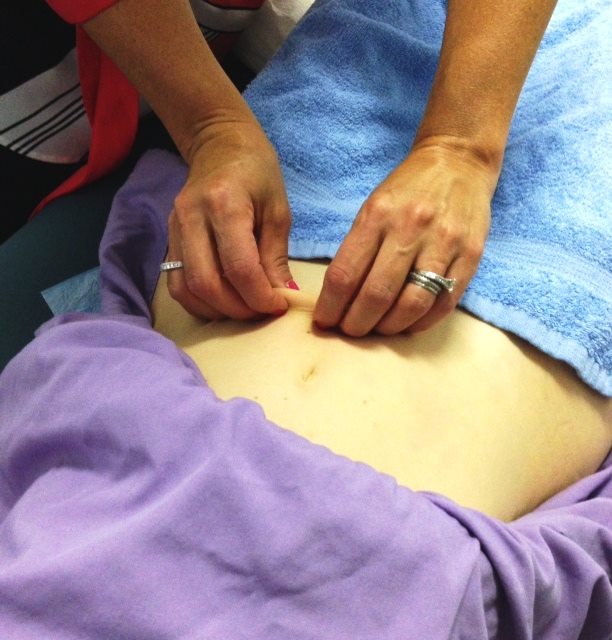 Skin rolling is a form of myofascial release. It is used to identify and treat areas of restriction or abnormal cross-linking of fascia or connective tissue in a painful area in the body. It is important to understand ‘fascia’ in order to understand the technique. Fascia is a loose irregular clear tissue (think about saran wrap) that covers the muscles, bones, nerves, organs, and blood vessels. Fascia can be subcutaneous: the layer between the skin and deep fascia, or can be deep fascia: the layer between and around muscles and other structures, holding them in place. Other fascia found in the body includes subserous which lines the body’s cavities and the deepest fascia covers the craniosacral system within the spine, cranium, and sacrum. When healthy, fascia looks like a spider web and is organized, pliable, and movable. It supports, protects, provides immune system function, fluid flow, separates body parts, and helps with respiration and elimination. Fascia helps the body to resist mechanical stresses. When trauma, infection, surgery, or inflammation occurs in an area of the body, fascia loses its pliability and can become “sticky” causing abnormal links between areas that are normally not attached or linked. This results in pain, loss of motion, and pressure in the area of abnormal cross-linking. Overtime, poor posture, loss of flexibility, immune system impairments, decreased lymphatic flow, and impedance to everyday function can result. Skin rolling can break up the abnormal cross links or adherences and restore normal fascia mobility. The therapist pinches the skin between their fingers (picking it up) and pulls the skin away from the underlying structures. Their fingers move along the surface of the skin continuously picking the skin up to stretch the subcutaneous fascia, break cross links, and make the tissue more mobile. The areas that do have restrictions or cross-links can be painful or sore as the technique is performed. Areas that were tight or restricted and released through skin rolling may turn red or release heat. This is a good response. Decreased pain, improved lymphatic flow, decreased swelling, improved nerve function, improved range of motion, and improved mobility and posture usually result. Many patients find significant relief with this technique and it can be utilized for many different diagnoses including chronic pelvic pain, low back pain, neuralgias such as pudendal neuralgia, breast pain, lymphedema, scar pain such as cesarean-section (c-section), and post surgical issues. We utilize this technique in conjunction with our many other manual therapies and modalities.
Skin rolling is a form of myofascial release. It is used to identify and treat areas of restriction or abnormal cross-linking of fascia or connective tissue in a painful area in the body. It is important to understand ‘fascia’ in order to understand the technique. Fascia is a loose irregular clear tissue (think about saran wrap) that covers the muscles, bones, nerves, organs, and blood vessels. Fascia can be subcutaneous: the layer between the skin and deep fascia, or can be deep fascia: the layer between and around muscles and other structures, holding them in place. Other fascia found in the body includes subserous which lines the body’s cavities and the deepest fascia covers the craniosacral system within the spine, cranium, and sacrum. When healthy, fascia looks like a spider web and is organized, pliable, and movable. It supports, protects, provides immune system function, fluid flow, separates body parts, and helps with respiration and elimination. Fascia helps the body to resist mechanical stresses. When trauma, infection, surgery, or inflammation occurs in an area of the body, fascia loses its pliability and can become “sticky” causing abnormal links between areas that are normally not attached or linked. This results in pain, loss of motion, and pressure in the area of abnormal cross-linking. Overtime, poor posture, loss of flexibility, immune system impairments, decreased lymphatic flow, and impedance to everyday function can result. Skin rolling can break up the abnormal cross links or adherences and restore normal fascia mobility. The therapist pinches the skin between their fingers (picking it up) and pulls the skin away from the underlying structures. Their fingers move along the surface of the skin continuously picking the skin up to stretch the subcutaneous fascia, break cross links, and make the tissue more mobile. The areas that do have restrictions or cross-links can be painful or sore as the technique is performed. Areas that were tight or restricted and released through skin rolling may turn red or release heat. This is a good response. Decreased pain, improved lymphatic flow, decreased swelling, improved nerve function, improved range of motion, and improved mobility and posture usually result. Many patients find significant relief with this technique and it can be utilized for many different diagnoses including chronic pelvic pain, low back pain, neuralgias such as pudendal neuralgia, breast pain, lymphedema, scar pain such as cesarean-section (c-section), and post surgical issues. We utilize this technique in conjunction with our many other manual therapies and modalities.
Skin Rolling: A Diagnostic and Treatment Myofascial Release Technique
Posted by webmaster on Aug 5, 2015 in Uncategorized



